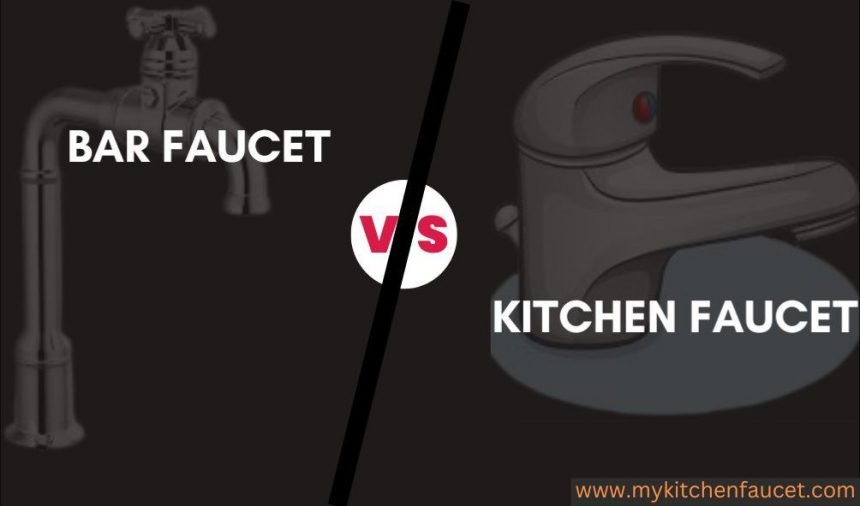There has long been a controversy about whether bar faucets or kitchen faucets are better.
We will differentiate between bar faucet vs. kitchen faucet in this article. What are they best used for, what are their pros and cons, and why do they differ?
Bar faucets and kitchen faucets are often seen as interchangeable. People only install one great sink, the main sink, while designing and building their kitchen.
Their budget may be restricted, so they constructed a single sink with the main faucet. However, after working in the kitchen, it may be challenging for people to utilize and operate a single faucet..
Therefore they put in another secondary sink with a small faucet to take care of the inconvenience, which boosts kitchen work efficiency. That small and secondary faucet is known as a bar faucet.
So without further hemming and hawing, let’s begin the discussion.
What are kitchen faucets?

Kitchen sink faucets usually have a couple of knobs for mixing hot and cold water or one handle that spins in one direction to vary the water temperature.
These frequently have a side-mounted sprayer. Since it is designed to be used with bigger kitchen sinks, the kitchen faucet is more prominent in stature.
Pros.
- Long extended neck design:
This reduces the water spilling out of the sink since the neck is lower into the sink.
- Available at various prices:
Due to the variety of types and finishes, you can discover kitchen faucets in various appealing options for your kitchen design. All kinds of kitchen faucets are available in both under-budget or opulent options.
- Broad compatibility:
A kitchen sink will perform well in both conditions, whether you have a top-mount or an under-mount sink.
Cons.
- Not suitable for bar sinks:
A bar faucet is smaller in size than a kitchen faucet. Consequently, installing a kitchen faucet on a bar sink will result in too much water flow and will affect your kitchen functionality.
What are Bar faucets?

A bar faucet is a faucet used in combination with a small auxiliary sink to make serving drinks easy. Spout heights on bar sink faucets typically range from 8 to 13 inches.
When the water is turned on, a faucet that is too high for the depth of the sink may cause splashing while washing glass.
Therefore a bar faucet is ideal for installing along with the main faucet. Its long handle can be adjusted deep down towards the drainage, and it will help you to wash dishes without splashing water.
Pros.
- Suitable for smaller areas:
Bar faucets have 4-inch centers, making them ideal for installation in smaller areas.
- Long spray handles:
Bar faucets are equipped with long spray handle that is moveable. You can pull the faucet inside the drainage to avoid water splashing.
- Effective as a drink center:
When this faucet is placed along with a beverage fridge and glassware storage, you have a beverages bar in your possession.
- Filtered water for drinking:
The bar faucet can be equipped with a filter so that water is filtered each time it is turned on.
- Immediate hot water:
To get hot water on desire, you may attach a hot water dispenser to the faucet.
Cons.
- For some kitchens only
Not every kitchen design is suitable for bar faucet design, and it is expensive.
Critical differences between Bar faucet vs. Kitchen faucets
| Bar faucets | Kitchen faucets |
|---|---|
| 6 inches in size and not higher than 13 inches from the sink | 8 inches in size and more than 13 inches away from the sink |
| It can be connected to water filters and dispensers | It cannot be combined with water dispensers and water filters. |
| Expensive | Available from cheaper to an expensive range of pricing |
| Have digital function and known in advance faucet features | Not have digital functions |
See the difference here for more updated knowledge:
FAQs:
- Are bar faucets and kitchen faucets compatible with the same sink?
They are suitable for a single sink, but the difference in their size will create some problems later on. The bar faucet is smaller and needs less space in a sink. Comparatively, kitchen faucets are more extensive and require a wide surface area of the sink. However, they can be put together with the help of professional assistance.
- Why do you need a bar faucet?
When you need some extra working space for washing dishes in your kitchen, you can connect the bar faucet with filters to get fresh filtered water. Moreover, you can combine water dispensers for getting hot and cold water through bar faucets.
- Why do you need kitchen faucets?
Kitchen faucets should be your main sink faucet while working in the kitchen as they are helpful and suitable in a busy kitchen. Its high spout is more suited if you clean plenty of wine glasses. Moreover, using a kitchen faucet when you have a top or under-mount sink is smarter.
Conclusion:
Finally, the bar faucet vs. kitchen faucet debate ends here. The endpoint is both a bar and a kitchen sink are excellent choices if your kitchen is well-organized.
However, if there isn’t much room, you may consider placing the bar someplace outside the kitchen to make things simpler.
But the kitchen sink must be your main faucet for efficient working in the kitchen.





